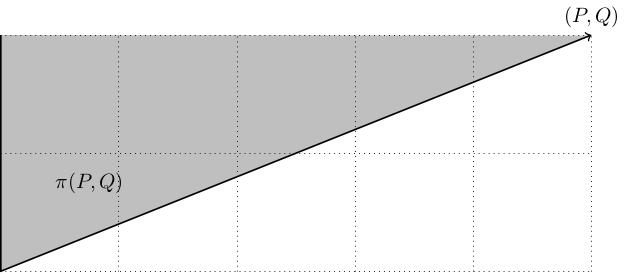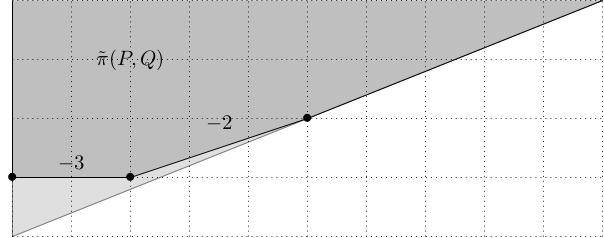Cyclic quotient singularities
[2018-06-02 Sat]
I have been reading the paper "Flipping surfaces" by Hacking, Tevelev
and Urzúa, which is a detailed study of a certain class of 3-fold
flips. There is some background material about cyclic quotient surface
singularities which I keep having to figure out from first principles
whenever I return to this stuff and it would be helpful to have it
written down somewhere. To that end, here is the first in a series of
posts about this, covering the toric model for cyclic quotient
singularities and the minimal resolution.
Toric picture of cyclic quotient singularities
Given coprime positive integers \(P,Q\), the cyclic quotient singularity of type \(\frac{1}{P}(1,Q)\) is defined to be the quotient \(\mathbf{C}^2/\Gamma\) where \(\Gamma\) is the action of the group of \(P^{th}\) roots of unity on \(\mathbf{C}^2\) given by \(\mu\cdot(x,y)=(\mu x,\mu^Q y)\).
The singularity \(\mathbf{C}^2/\Gamma\) admits a Hamiltonian torus
action generated by a moment map
\(\mu\colon\mathbf{C}^2/\Gamma\to\mathbf{R}^2\) whose image is the
wedge \[\pi(P,Q):=\{(x,y)\in\mathbf{R}^2\ :\ x\geq 0,\ Py\geq
Qx\}.\]

The Hamiltonian functions \(H_1(x,y):=\frac{1}{2}|x|^2\) and
\(H_2(x,y):=\frac{1}{2}|y|^2\) on \(\mathbf{C}^2/\Gamma_{P,Q}\)
Poisson-commute and generate an \(\mathbf{R}^2\)-action whose period
lattice is the set of points
\[(\phi_1,\phi_2)=\left(2\pi\left(\frac{k}{P}+\ell\right),
2\pi\left(\frac{kQ}{P}+m\right)\right),\quad
k,\ell,m\in\mathbf{Z}.\] (The period lattice for an
\(\mathbf{R}^n\)-action is the set of points in \(\mathbf{R}^n\)
which act as the identity.) The Hamiltonians
\(\frac{1}{P}(H_1+QH_2)\) and \(H_2\) therefore give us the standard
period lattice \(2\pi\mathbf{Z}\oplus 2\pi\mathbf{Z}\), therefore
define an effective Hamiltonian torus action. The image of
\(\mathbf{C}^2/\Gamma_{P,Q}\) under
\(\mu=\left(H_2,\frac{1}{P}(H_1+QH_2)\right)\) is precisely the
polygon \(\pi(P,Q)\).
Minimal resolution
The minimal resolution \(\pi\colon\tilde{X}\to X\) of a cyclic quotient singularity \(X\) of type \(\frac{1}{P}(1,Q)\) has the following exceptional locus: it is a Hirzebruch-Jung chain of embedded spheres \(C_1,\ldots,C_r\):


- The first truncation should be made horizontally: this is the obvious way to ensure that the left-most vertex is Delzant.
- The new right-hand vertex now has outgoing edge vectors \((-1,0)\) and \((P,Q)\); if we write \(P=b_1Q-R_1\) for some \(0\leq R_1\leq Q-1\) then the matrix \(\left(\begin{array}{cc}0&1\\ -1&b_1\end{array}\right)\) applied to these edge vectors sends them to \((0,1)\) and \((Q,R_1)\), so the new right-hand vertex corresponds to a cyclic quotient singularity of type \(\frac{1}{Q}(1,R_1)\). If \(R_1=0\) then this vertex is smooth, so we stop truncating.
- Otherwise, having put this right-hand vertex into this position, we again make a horizontal truncation to make this vertex Delzant. We introduce a new right-hand vertex, and proceed in the same manner.
- Eventually, we get to the point where the remainder \(R_r\) vanishes
so the process terminates (this is essentially the Euclidean
algorithm). At this point, the final outgoing edge is pointing in
the \((1,0)\)-direction.